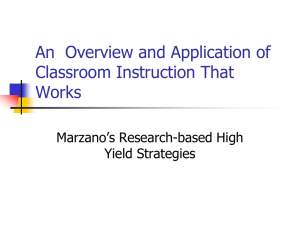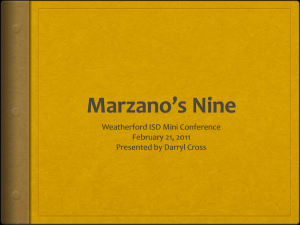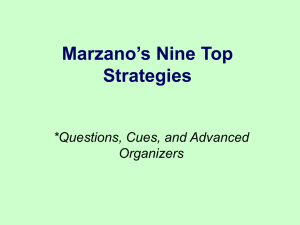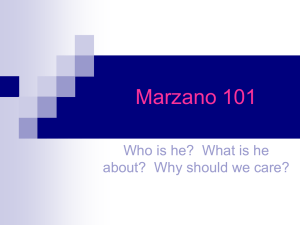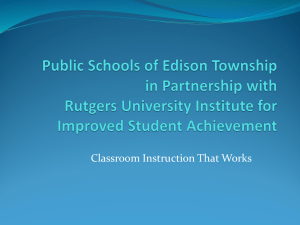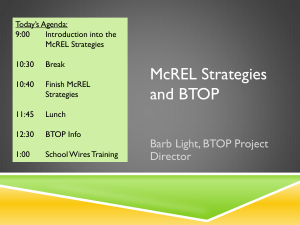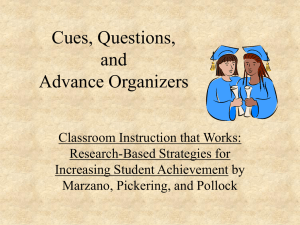BEST PowerPoint
advertisement
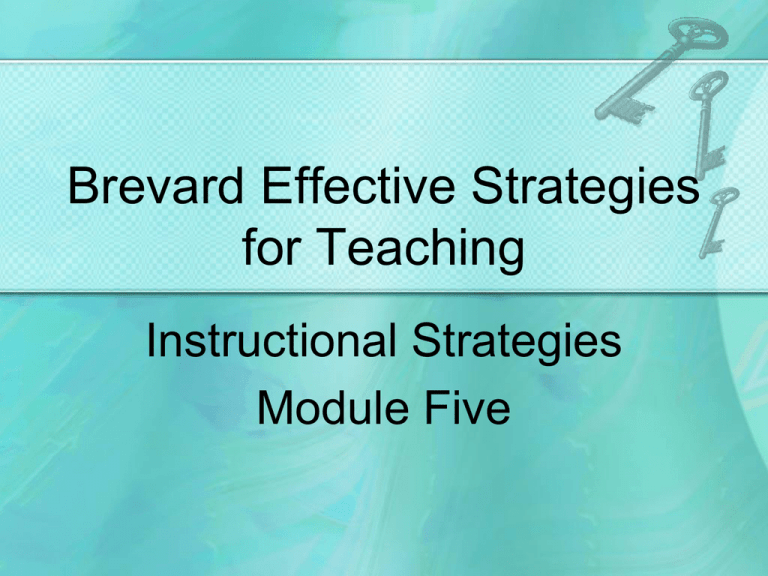
Brevard Effective Strategies for Teaching Instructional Strategies Module Five Desired Outcomes: • Understanding of Research-Based Instructional Strategies • Comprehend and Apply Four Instructional Strategies – – – – Setting Objectives and Providing Feedback Generating and Testing Hypothesis Questions, Cues and Advance Organizers Cooperative Learning • Applying Strategies for ALL Learners • Integrating Technology Module 2 Multiple Intelligences Module 1 Why Module 6 Lesson Design BEST Module 5 Instructional Strategies Module 3 Classroom Organization Module 4 Assessment These strategies are tools to… • Highly engage all students for increased learning • Develop higher level thinking and deeper understanding of concepts NOT ONE SIZE FITS ALL Number Search • Do not look at your paper! • When time begins, circle numbers in order (1, 2, 3 etc) • You will have 30 seconds to find the numbers. • Ready, set…. Marzano’s Nine Instructional Strategies • Research-based • A high correlation with student achievement connection •A between what we know works and classroom instruction Nine Instructional Strategies Identifying similarities and differences Summarizing and note taking Nonlinguistic representation Homework and practice Reinforcing effort and providing recognition Setting objectives and providing feedback Generating and testing hypotheses Questions, cues, and advance organizers Cooperative learning Identifying Similarities and Differences • Comparisons • Classifying • Metaphors • Analogies Summarizing and Note Taking • Delete, keep, substitute information • Analysis of information Non-linguistic • Kinesthetic • Mental models • Graphic organizers Homework and Practice • Purpose • Feedback • Minimal parental involvement Reinforcing effort and Providing Recognition • Symbolic rather than tangible • Pause, prompt, praise • Celebrate the learning and effort Your Turn • At your tables, create a graphic organizer • Choose two strategies to compare Identifying similarities and differences Summarizing and note taking Nonlinguistic representation Homework and practice Reinforcing effort and providing recognition A closer look • Setting Objectives and Providing Feedback • Generating and Testing Hypothesis • Questions, Cues, and Advanced Organizers • Cooperative Learning Setting Objectives • Can you imagine???? Setting Objectives & Providing Feedback • Learning goals • Student driven • Feedback is timely and corrective Setting Objectives What it looks like: • Specific and flexible • Narrows what students focus on • Students should create personal goals based on teacher-created goals • Students understand how the objective connects to the lesson Setting Objectives • What it does not look like: –Too narrow or specific (focused on a detail) – An activity to be completed –Owned by ONLY the teacher Too Narrow or Too Broad? 1. Students will complete main idea summary. 2. Students will write two reasons for the Civil War in their support journals. Learning Objective The students will apply technology skills to research new medical innovations in st the 21 century. Video Clip for Setting Objectives and Providing Feedback Student-Created Learning Objective To increase my understanding ........ To increase my ability ............. To create........... To develop ............ To learn [how to, the relationship between X and Y, about]............ To research............ To improve......... Providing Feedback What does it look like? • Timely • Specific to a set criterion • Focused on improvement • Reflection and self assessment for student Providing Feedback What does it look like? • Constructive and helpful feedback • Formative assessment guides instruction and informs the students of their level of understanding • It is a GPS- Tells you where you are and guides you to where you are trying to go Feedback What it does not look like? • Criticism • Summative Only-not just a unit test • General • Just marking right or wrong Research Results for Corrective Feedback 20 Right/Wrong Answer 15 Correct Answer Only 10 5 Repeat Until Correct 0 Explanation -5 Percentile Gain Feedback • Formal –Rubric –Narrative comments –Portfolios • Informal –Conferencing –On-the-spot reinforcement When setting and communicating learning objectives, I believe my students… • Can explain their learning, not just the activity they are doing. • Can personalize the learning goals. When providing feedback to my students, I believe they… • Understand their progress as it relates to the learning goals • Use the information to improve their learning Tying it Together • Standards • Objectives –Teacher and Student • Feedback –Teacher and Student Connections for Learning • • • • Student Response Systems Thumbs up, thumbs down White boards Student-Driven Portfolios – Electronic – Paper Copy • Wikis and Blogs • KWL Praise Question Polish (PQP) • • • • • Turn to your neighbor Write a learning objective together Join forces with another pair Each pair shares their objective Take turns PRAISING, QUESTIONING, and POLISHING Generalizing and Testing Hypotheses • Hook video Generating and Testing Hypotheses • System analysis • Problem solving • Invention & inquiry Generating and Testing Hypotheses • What it looks like? – Relevant to all subjects – Investigation or inquiry – Predictions • Deductive Reasoning-making a prediction about a future action or event • Inductive Reasoning-drawing conclusion based on what you know or will know Generating and Testing Hypotheses • What it does not look like –Only ONE answer –Correct answer before research or investigation Structured Tasks for Generating and Testing Hypothesis • Systems Analysis • • • • • Problem Solving Historical Investigation Invention Experimental Inquiry Decision Making Generating and Testing Hypotheses • Video of example-not in science Making Connections • • • • • • • Virtual Field Trips Socratic Seminar Science Research Probability in Math Social Studies-Past and History Past to Present- Social Studies DBQ (Document Based Questions) Questions, Cues, and Advance Organizers • Wait time • Focus on important points • Textual or factual support Read the quote-what will be the ending? Write you answer down. As a kid, I learned that my brother and I could walk forever on a railroad track and never fall off if we just… Steve Potter • Go to the corner that is closest to your prediction. • One corner is set aside for those who had something completely different. • How does your quote differ from the actual quote? What does it mean? Questions, Cues and Advance Organizer • Develop a KWL or a Circle Map • Three Sections – What do you Know – What do you Want to Know – What did you Learn (to be completed later) K W L Questions and Cues • What it looks like – Focus on what is important as opposed to what is unusual – Deepens thinking • Wait time • Higher level questions – Questions used to establish a mental model before a learning experience Question Starters • Why do you think… • Describe… • How do you feel… • What was your reaction… • How would you… • Where did you… WRITE YOUR OWN STARTER-SHARE WITH THE TABLE Advance Organizers What it looks like • Prior to learning • Expository – stick to the facts • Narrative- story format • Personal story shared that relates to topic • Skimming- before learning, big ideas • Graphic organizer-Created by the teacher to see the whole picture Questions and Cues and Advance Organizers What it does not look like: • • • • • A yes or no answer Final copy Graded piece Assessment An interrogation Questions, Cues and Advance Organizers • Video Connections • • • • • CRISS and NICK Strategies Thinking Maps Digital Photography Distance Learning- example NASA Field Trip (speakers) Questions, Cues and Organizers • Complete what you Learned in the KWL or Circle Map No one can be the best at everything. But when we combine our talents, we can and will be the best at virtually anything. Dan Zadra Math Challenge • Math Activity • Three sections of math • Time to test your math skills! Cooperative learning • Small groups • Specific directions • Structured Cooperative Learning The most research-based strategy that improves learning. Students work together to accomplish a common goal. Cooperative Learning Key Concepts • • • • • Positive Interdependence Individual Accountability Equal Participation Simultaneous Interaction Group Processing (Marzano) Cooperative Learning • Groups –Informal –Formal Cooperative Learning What it does not look like • Chaos • “Group” work with no structure/accountability • Hogs and logs If we are to live and work together, we have to talk to each other. Eleanor Roosevelt Cooperative Learning • video Connections • Thinking Maps • Cognitive Academic Language Learner Approach (CALLA) • Webquest • Creating Digital Stories • Animoto • PhotoStory • Digital Language Experience Approach (DLEA) Give One Take One Give One Idea 1 Idea 2 Idea 3 Idea 4 Take One ESOL instructional strategies: • Total Physical Response (TPR) by Asher • Cognitive Academic Language Learning Approach (CALLA) by Chamot and O’Malley • Language Experience Approach (LEA) • Communicative Approach Key Concepts • Marzano’s Nine Instructional Strategies • Today’s focus: – Setting Objectives and Providing Feedback – Generalizing and Testing Hypothesis – Questions, Cues and Advance Organizers – Cooperative Learning What’s Next • Determine school and teacher needs for Professional learning Community • Examine resources • Apply strategies and refine methods Education is not preparation for life, education is life itself. John Dewey What Works in Schools: Translating Research into Action; Marzano (2003) Classroom Instruction that Works: Research Based Strategies for Increasing Student Achievement; Marzano, Pickering, & Pollock (2001)
